Linux PDAs, PMPs, PNDs, and other Handhelds
Feb 24, 2002 — by Eric Brown — from the LinuxDevices Archive — 754 viewsThis guide provides a sampling of PDAs (personal digital assistants), PMPs (portable media players), PNDs (portable navigation devices), and other handheld devices based on Linux that have been covered in LinuxDevices.In some cases there is a fine line between these handhelds and slightly larger handheld (typically two-handed) devices that we have listed under the separate Linux MIDs, UMPCs, and Tablets showcase. Devices with built-in cellular phone functions, meanwhile, are listed in our Linux Mobile Phones showcase.
 HardKernel Odroid — Dec. 10. 1009 — HardKernel's developer-focused handheld game device runs Android and offers source code, schematics, and a debug board. The $350 Odroid is based on a Cortex-A8 Samsung S5PC100 clocked to 833Mhz, and offers 10GB of flash, a 3.5-inch touchscreen, 720p video via HDMI, plus WiFi, Bluetooth, and accelerometers.
HardKernel Odroid — Dec. 10. 1009 — HardKernel's developer-focused handheld game device runs Android and offers source code, schematics, and a debug board. The $350 Odroid is based on a Cortex-A8 Samsung S5PC100 clocked to 833Mhz, and offers 10GB of flash, a 3.5-inch touchscreen, 720p video via HDMI, plus WiFi, Bluetooth, and accelerometers.
 Pascal Brisset WXHMD — Nov. 4, 2009 — Hardware hacker Pascal Brisset's Linux-driven head-mounted computer is based on a stereoscopic, 640 x 480 Vusix VR920 headmount display and the Gumstix Overo Fire module running the ARM Cortex-A8 OMAP3530 processor from Texas Instruments. The open source, six-ounce "WXHMD" includes WiFi, Bluetooth, accelerometers, compass, and a custom-made DAC board.
Pascal Brisset WXHMD — Nov. 4, 2009 — Hardware hacker Pascal Brisset's Linux-driven head-mounted computer is based on a stereoscopic, 640 x 480 Vusix VR920 headmount display and the Gumstix Overo Fire module running the ARM Cortex-A8 OMAP3530 processor from Texas Instruments. The open source, six-ounce "WXHMD" includes WiFi, Bluetooth, accelerometers, compass, and a custom-made DAC board.
 Archos 5 (Android edition) — Sep. 15, 2009 — This Android version of Archos' media-oriented Archos 5 Internet Tablet portable media player runs on a Texas Instruments OMAP3x SoC, and comes in flash (8GB to 32GB) or hard drive versions (160GB to 500GB). The Android-ready Archos 5 offers a 4.8-inch, 800 x 480 touchscreen, 720p video, GPS, WiFi, and Bluetooth.
Archos 5 (Android edition) — Sep. 15, 2009 — This Android version of Archos' media-oriented Archos 5 Internet Tablet portable media player runs on a Texas Instruments OMAP3x SoC, and comes in flash (8GB to 32GB) or hard drive versions (160GB to 500GB). The Android-ready Archos 5 offers a 4.8-inch, 800 x 480 touchscreen, 720p video, GPS, WiFi, and Bluetooth.
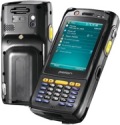 SDG Systems (Bluebird Soft) BIP-6000 — Aug. 11, 2009 — This SDG Systems Linux port of Bluebird Soft's rugged, Windows Mobile-based handheld PDA is aimed at applications including parcel delivery. The BIP-6000 offers a 3.5-inch VGA touchscreen, three-megapixel camera, 1D/2D barcode scanner, RFID and IrDA readers, WiFi, GPS, and HDSPA.
SDG Systems (Bluebird Soft) BIP-6000 — Aug. 11, 2009 — This SDG Systems Linux port of Bluebird Soft's rugged, Windows Mobile-based handheld PDA is aimed at applications including parcel delivery. The BIP-6000 offers a 3.5-inch VGA touchscreen, three-megapixel camera, 1D/2D barcode scanner, RFID and IrDA readers, WiFi, GPS, and HDSPA.
 ZiiLabs Zii Egg StemCell Computer — Jul. 29, 2009 — This developer-focused portable media player (PMP) from Creative Technology subsidiary ZiiLabs is based on a homegrown, dual ARM-core "ZMS-05" SoC and "Plaszma" Linux distribution. The Zii Egg StemCell Computer offers a 3.5-inch display supporting 1080p HD video, plus an HD video camera, WiFi, GPS, Bluetooth, an SDK, and optional Android.
ZiiLabs Zii Egg StemCell Computer — Jul. 29, 2009 — This developer-focused portable media player (PMP) from Creative Technology subsidiary ZiiLabs is based on a homegrown, dual ARM-core "ZMS-05" SoC and "Plaszma" Linux distribution. The Zii Egg StemCell Computer offers a 3.5-inch display supporting 1080p HD video, plus an HD video camera, WiFi, GPS, Bluetooth, an SDK, and optional Android.
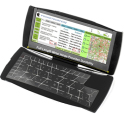 Datawind PocketSurfer3 and PocketSurfer3 Lite — Jul. 10, 2009 — Datawind's updated versions of its PocketSurfer 2 clamshell PDA have moved to embedded Linux, and for communications, depends solely on GPRS service, which is offered for free by the company in the U.K. The PocketSurfer3 (pictured) and PocketSurfer3 Lite measure 6.0 x 4.0 x 0.6 inches, and offer 5-inch, 640 x 240 active matrix TFT screens, with the Lite version differing due to its lack of GPS and its use of four-way controls instead of a mousepad.
Datawind PocketSurfer3 and PocketSurfer3 Lite — Jul. 10, 2009 — Datawind's updated versions of its PocketSurfer 2 clamshell PDA have moved to embedded Linux, and for communications, depends solely on GPRS service, which is offered for free by the company in the U.K. The PocketSurfer3 (pictured) and PocketSurfer3 Lite measure 6.0 x 4.0 x 0.6 inches, and offer 5-inch, 640 x 240 active matrix TFT screens, with the Lite version differing due to its lack of GPS and its use of four-way controls instead of a mousepad.
 Kopin Golden-i — May 20, 2009 — Kopin collaborated with Motorola to build a computer into a Bluetooth headset, providing a "virtual 15-inch display" via a swing-down eyepiece. The "Golden-i" incorporates speech recognition, weighs three ounces, and runs Linux software for more than eight hours per charge.
Kopin Golden-i — May 20, 2009 — Kopin collaborated with Motorola to build a computer into a Bluetooth headset, providing a "virtual 15-inch display" via a swing-down eyepiece. The "Golden-i" incorporates speech recognition, weighs three ounces, and runs Linux software for more than eight hours per charge.
 BlueRadios WiPC — May 8, 2009 — BlueRadios' "near-eye" portable media player is equipped with an SVGA micro-display that is touted as offering the viewing experience of a 15-inch display. The WiFi-enabled WiPC runs Linux or Android on an ARM Cortex-A8 OMAP3530 SoC, weighs three ounces, and consumes
BlueRadios WiPC — May 8, 2009 — BlueRadios' "near-eye" portable media player is equipped with an SVGA micro-display that is touted as offering the viewing experience of a 15-inch display. The WiFi-enabled WiPC runs Linux or Android on an ARM Cortex-A8 OMAP3530 SoC, weighs three ounces, and consumes
one Watt.
 GiiNii Movit Mini and Movit Maxx — Apr. 17, 2009 — GiiNii's portable media player (PMP) and digital picture frame (DPF) include touchscreens, WiFi, a webcam, and optional Bluetooth. The Movit Mini portable (pictured) and larger Movit Maxx DPF both run the Linux/Java Android stack.
GiiNii Movit Mini and Movit Maxx — Apr. 17, 2009 — GiiNii's portable media player (PMP) and digital picture frame (DPF) include touchscreens, WiFi, a webcam, and optional Bluetooth. The Movit Mini portable (pictured) and larger Movit Maxx DPF both run the Linux/Java Android stack.
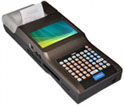 Procsys Ion 2600 — Apr. 15, 2009 — This POS (point of service) handheld from India-based Procsys sports an Intel Atom CPU and a built-in thermal printer. The "Ion 2600" includes a fingerprint sensor, RFID reader/writer, LAN and WAN connectivity, and a 4.1-inch touchscreen display.
Procsys Ion 2600 — Apr. 15, 2009 — This POS (point of service) handheld from India-based Procsys sports an Intel Atom CPU and a built-in thermal printer. The "Ion 2600" includes a fingerprint sensor, RFID reader/writer, LAN and WAN connectivity, and a 4.1-inch touchscreen display.
 Artec Triskan TS8 Professional Mobile Terminal — Nov. 12, 2008 — This data-collection barcode scanner and PDA from Estonia-based Artec offers an OLED display. Billed as the first OLED-equipped mobile terminal device, Artec's Triskan TS8 Professional Mobile Terminal runs embedded Linux on an ARM processor, and includes Bluetooth and GSM/GPRS, with optional WiFi.
Artec Triskan TS8 Professional Mobile Terminal — Nov. 12, 2008 — This data-collection barcode scanner and PDA from Estonia-based Artec offers an OLED display. Billed as the first OLED-equipped mobile terminal device, Artec's Triskan TS8 Professional Mobile Terminal runs embedded Linux on an ARM processor, and includes Bluetooth and GSM/GPRS, with optional WiFi.
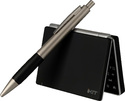 Imovio iKit — Oct. 20, 2008 — Imovio's WiFi- and Bluetooth-enabled clamshell PDA runs the Linux-based Qt Extended stack. Very similar to the Sharp Zaurus, the iKit is based on a Marvell PXA270 processor, with 128MB RAM, 64MB flash, and a 2.8 inch QVGA display.
Imovio iKit — Oct. 20, 2008 — Imovio's WiFi- and Bluetooth-enabled clamshell PDA runs the Linux-based Qt Extended stack. Very similar to the Sharp Zaurus, the iKit is based on a Marvell PXA270 processor, with 128MB RAM, 64MB flash, and a 2.8 inch QVGA display.
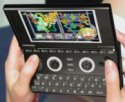 OpenPandora Pandora — Sep. 17, 2008 — OpenPandora.org's developer-friendly handheld gaming device runs Angstrom Linux on an ARM Cortex-A8 OMAP3530 processor with OpenGL 2.0 graphics. The $330 Pandora offers a 4.3-inch, 800 x 480 touchscreen, a QWERTY keyboard and analog nubs, 128MB of SDRAM, 256MB of flash, plus WiFi and USB.
OpenPandora Pandora — Sep. 17, 2008 — OpenPandora.org's developer-friendly handheld gaming device runs Angstrom Linux on an ARM Cortex-A8 OMAP3530 processor with OpenGL 2.0 graphics. The $330 Pandora offers a 4.3-inch, 800 x 480 touchscreen, a QWERTY keyboard and analog nubs, 128MB of SDRAM, 256MB of flash, plus WiFi and USB.
 Cool-Idea Technology Cool-Karaoke — Sep. 05, 2008 — Cool-Idea Technology's open-source MP3, video, and Karaoke player is equipped with a 400MHz ARM920t processor, 4GB of flash, and a 320×240 display. The hackable Cool-Karaoke comes with a freely downloadable Linux toolchain and source code, and offers numerous hardware mixers to improve synchronization with recorded music.
Cool-Idea Technology Cool-Karaoke — Sep. 05, 2008 — Cool-Idea Technology's open-source MP3, video, and Karaoke player is equipped with a 400MHz ARM920t processor, 4GB of flash, and a 320×240 display. The hackable Cool-Karaoke comes with a freely downloadable Linux toolchain and source code, and offers numerous hardware mixers to improve synchronization with recorded music.
 Archos 5 and Archos 7 — Aug. 21, 2008 — These next-generation Archos portable media players (PMPs) use ARM Cortex-based processors. The Linux-based Archos 5 and Archos 7 (pictured) provide 4.8- and 7-inch touchscreens, respectively, and include WiFi, hard drives, and an optional 3.5G cellular connection.
Archos 5 and Archos 7 — Aug. 21, 2008 — These next-generation Archos portable media players (PMPs) use ARM Cortex-based processors. The Linux-based Archos 5 and Archos 7 (pictured) provide 4.8- and 7-inch touchscreens, respectively, and include WiFi, hard drives, and an optional 3.5G cellular connection.
 Clarion ClarionMind — Aug. 20, 2008 — Clarion's Linux-based personal navigation device (PND) is based on an 800MHz Z500 Intel Atom processor, blurring the lines between PND and general-purpose mobile Internet device (MID). The media- and web-savvy ClarionMind is equipped with a 4.8-inch 800×480 touchscreen, WiFi, and a GPS receiver, but offers no map database of its own, instead relying on Internet-based map sites.
Clarion ClarionMind — Aug. 20, 2008 — Clarion's Linux-based personal navigation device (PND) is based on an 800MHz Z500 Intel Atom processor, blurring the lines between PND and general-purpose mobile Internet device (MID). The media- and web-savvy ClarionMind is equipped with a 4.8-inch 800×480 touchscreen, WiFi, and a GPS receiver, but offers no map database of its own, instead relying on Internet-based map sites.
 Aceeca Meazura MEZ1500 — Aug. 07, 2008 — The Meazura MEZ1500 from New Zealand-based Aceeca International is a ruggedized handheld that runs Linux. The Meazura MEZ1500 has a Marvell PXA270 processor, and a proprietary "MZIO" expansion slot that carries SPI (serial peripheral interface) signals, allowing the attachment of custom A/D (analog/digital) converter modules.
Aceeca Meazura MEZ1500 — Aug. 07, 2008 — The Meazura MEZ1500 from New Zealand-based Aceeca International is a ruggedized handheld that runs Linux. The Meazura MEZ1500 has a Marvell PXA270 processor, and a proprietary "MZIO" expansion slot that carries SPI (serial peripheral interface) signals, allowing the attachment of custom A/D (analog/digital) converter modules.
 Trinity Audio Group Indamixx — Jul. 24, 2008 — A handheld multi-track recording device that integrates the 64Studio Linux music distribution with an off-the-shelf Samsung Q1 Ultra handheld, so audio producers can record, edit, equalize, audition, and mix audio at up to 32-bit/96Khz rates on-the-go.
Trinity Audio Group Indamixx — Jul. 24, 2008 — A handheld multi-track recording device that integrates the 64Studio Linux music distribution with an off-the-shelf Samsung Q1 Ultra handheld, so audio producers can record, edit, equalize, audition, and mix audio at up to 32-bit/96Khz rates on-the-go.
 Noah Education Holdings NC200, NP1100, and NP1000 — Jul. 14, 2008 — Doubling as a portable Chinese language course-ware device and a "travel companion" for Beijing Olympics attendees, these devices come with Linux-based software that includes a pictorial dictionary, terminology dictionary, multi-language dictionary, and a "role-play function."
Noah Education Holdings NC200, NP1100, and NP1000 — Jul. 14, 2008 — Doubling as a portable Chinese language course-ware device and a "travel companion" for Beijing Olympics attendees, these devices come with Linux-based software that includes a pictorial dictionary, terminology dictionary, multi-language dictionary, and a "role-play function."
 Garmin Nuvi 860, 880, and 5000 — Jul. 02, 2008 — The Nuvi 860 and 880 offer a 4.3-inch, 480×272 display, and appear to be based on a Marvell PXA-3xx processor, Gnome Mobile Linux, and GeoClue location technology. Designed for truckers, the 5000 runs off automotive power only, and lacks the Nuvi 880's voice recognition, Bluetooth support, and some other advanced features. However, it offers a larger 5.2-inch display, with a higher 800×480 resolution.
Garmin Nuvi 860, 880, and 5000 — Jul. 02, 2008 — The Nuvi 860 and 880 offer a 4.3-inch, 480×272 display, and appear to be based on a Marvell PXA-3xx processor, Gnome Mobile Linux, and GeoClue location technology. Designed for truckers, the 5000 runs off automotive power only, and lacks the Nuvi 880's voice recognition, Bluetooth support, and some other advanced features. However, it offers a larger 5.2-inch display, with a higher 800×480 resolution.
 Samsung i70 PMP — Jun. 20, 2008 — A style-conscious Samsung digital camera and personal media player (PMP) built on a MontaVista Linux platform, the Samsung i70's built-in digital camera boasts 7.2-megapixel resolution, a 3x optical zoom, and Samsung's ASR (Advanced Shake Reduction) technology.
Samsung i70 PMP — Jun. 20, 2008 — A style-conscious Samsung digital camera and personal media player (PMP) built on a MontaVista Linux platform, the Samsung i70's built-in digital camera boasts 7.2-megapixel resolution, a 3x optical zoom, and Samsung's ASR (Advanced Shake Reduction) technology.
 Slacker Portable — May 27, 2008 — A personal music player (PMP) claimed to connect itself automatically to "hundreds of thousands" of WiFi hotspots, the Slacker Portable offers a mobile version of Slacker's Web-based Slacker Personal Radio browser, which the company claims enables users to personalize over 100 professionally programmed stations.
Slacker Portable — May 27, 2008 — A personal music player (PMP) claimed to connect itself automatically to "hundreds of thousands" of WiFi hotspots, the Slacker Portable offers a mobile version of Slacker's Web-based Slacker Personal Radio browser, which the company claims enables users to personalize over 100 professionally programmed stations.
 SDG Systems TDS Nomad — May 01, 2008 — SDG is a value-added reseller of mobile computers and PDAs that has ported Linux to the "Nomad," a ruggedized, "military-grade" PDA made by Tripod Data Systems (TDS). The SDG version of the Nomad comes pre-installed with Angstrom Linux and Qtopia PDA Edition, and bundled with a toolsuite and build environment based on OpenEmbedded.
SDG Systems TDS Nomad — May 01, 2008 — SDG is a value-added reseller of mobile computers and PDAs that has ported Linux to the "Nomad," a ruggedized, "military-grade" PDA made by Tripod Data Systems (TDS). The SDG version of the Nomad comes pre-installed with Angstrom Linux and Qtopia PDA Edition, and bundled with a toolsuite and build environment based on OpenEmbedded.
 SanDisk Sansa e200 with "Podzilla" — Apr. 07, 2008 — SanDisk's relatively inexpensive e200 line of flash-based mp3 players can be altered to run Podzilla, an open source media player stack originally developed by the iPod Linux project.
SanDisk Sansa e200 with "Podzilla" — Apr. 07, 2008 — SanDisk's relatively inexpensive e200 line of flash-based mp3 players can be altered to run Podzilla, an open source media player stack originally developed by the iPod Linux project.
—
–>
 iWave iW-Rainbow-G4 — Mar. 27, 2008 — This rugged industrial PDA from iWave Systems of Bangalore is targeted at asset, inventory, and retail management. Available with RFID, WiFi, and GSM/GPRS/EDGE connectivity, the iW-Rainbow-G4 can withstand six-foot drops, and includes a 3.5-inch touchscreen and a sealed keyboard.
iWave iW-Rainbow-G4 — Mar. 27, 2008 — This rugged industrial PDA from iWave Systems of Bangalore is targeted at asset, inventory, and retail management. Available with RFID, WiFi, and GSM/GPRS/EDGE connectivity, the iW-Rainbow-G4 can withstand six-foot drops, and includes a 3.5-inch touchscreen and a sealed keyboard.
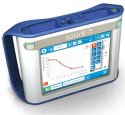 Pasco Spark Science Learning System — Mar. 26, 2008 — Pasco's 6.7 x 5.5 x 1.7-inch science education computer runs embedded Debian Linux. The sensor-equipped Spark Science Learning System incorporates a 320MHz Marvell PXA270, 1GB flash, a 5.7-inch VGA display, and two USB ports, and is designed for collaborative science experiments.
Pasco Spark Science Learning System — Mar. 26, 2008 — Pasco's 6.7 x 5.5 x 1.7-inch science education computer runs embedded Debian Linux. The sensor-equipped Spark Science Learning System incorporates a 320MHz Marvell PXA270, 1GB flash, a 5.7-inch VGA display, and two USB ports, and is designed for collaborative science experiments.
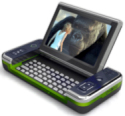 Miu HDPC — Mar. 24, 2008 — Miu's cell-phone enabled, x86-based nano-PC uses a 500MHz Via C7-M processor, as well as a 200MHz ARM9-based system-on-chip that runs an unspecified mobile phone OS. The HDPC ("hybrid dual portable computer") proof-of-concept design offers a 4-inch, WVGA inner screen and a 2.2-inch, 320×240 outer display, and comes with a 30/60GB hard drive or 4GB SSD.
Miu HDPC — Mar. 24, 2008 — Miu's cell-phone enabled, x86-based nano-PC uses a 500MHz Via C7-M processor, as well as a 200MHz ARM9-based system-on-chip that runs an unspecified mobile phone OS. The HDPC ("hybrid dual portable computer") proof-of-concept design offers a 4-inch, WVGA inner screen and a 2.2-inch, 320×240 outer display, and comes with a 30/60GB hard drive or 4GB SSD.
 Motorola Mobile TV DH01 — Jan. 07, 2008 — Motorola's Mobile TV DH01 personal media player (PMP) is designed for the emerging wireless TV broadcast standard, DVB-H (digital video broadcast, handhelds), enabling the viewing of live, on-demand, and recorded DVB-H programs. The device, which includes a 4.3-inch WQVGA display, was later upgraded to a DH02 model that adds a larger screen and a cellular phone.
Motorola Mobile TV DH01 — Jan. 07, 2008 — Motorola's Mobile TV DH01 personal media player (PMP) is designed for the emerging wireless TV broadcast standard, DVB-H (digital video broadcast, handhelds), enabling the viewing of live, on-demand, and recorded DVB-H programs. The device, which includes a 4.3-inch WQVGA display, was later upgraded to a DH02 model that adds a larger screen and a cellular phone.
 Dreamax Indicube i-800 PMP — Jan. 07, 2008 — This 2.3 x 4.8 x 0.9-inch portable media player (PMP) from Dreamax is equipped with a separate 0.44-inch, head-mounted OLED microdisplay visor with 800 x 600 resolution. The Indicube i-800 PMP is equipped with 12GB of storage plus an 8GB flash card, and the microdisplay is said to offer an experience equivalent to sitting seven feet from a 54-inch screen.
Dreamax Indicube i-800 PMP — Jan. 07, 2008 — This 2.3 x 4.8 x 0.9-inch portable media player (PMP) from Dreamax is equipped with a separate 0.44-inch, head-mounted OLED microdisplay visor with 800 x 600 resolution. The Indicube i-800 PMP is equipped with 12GB of storage plus an 8GB flash card, and the microdisplay is said to offer an experience equivalent to sitting seven feet from a 54-inch screen.
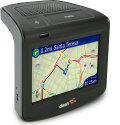 Dash Navigation Dash Express — Jan. 04, 2008 — Dash Navigation's WiFi- and GPRS/GSM-equipped navigation device is based on the OpenMoko Neo FreeRunner mobile phone platform. The Dash Express boasts continual two-way Internet communications, with the device selecting either cellular radio or WiFi to download traffic data, map updates, and other information.
Dash Navigation Dash Express — Jan. 04, 2008 — Dash Navigation's WiFi- and GPRS/GSM-equipped navigation device is based on the OpenMoko Neo FreeRunner mobile phone platform. The Dash Express boasts continual two-way Internet communications, with the device selecting either cellular radio or WiFi to download traffic data, map updates, and other information.
 Haier Ibiza Rhapsody — Nov. 26, 2007 — Haier America's WiFi-enabled portable media player (PMP) is designed to work with the Rhapsody digital music service, AOL Video, and other digital content services. The 2.4 x 0.5 x 4.1-inch Ibiza Rhapsody offers a 30GB hard drive, and is equipped with a 2.5-inch, 320 x 240-pixel QVGA LCD display
Haier Ibiza Rhapsody — Nov. 26, 2007 — Haier America's WiFi-enabled portable media player (PMP) is designed to work with the Rhapsody digital music service, AOL Video, and other digital content services. The 2.4 x 0.5 x 4.1-inch Ibiza Rhapsody offers a 30GB hard drive, and is equipped with a 2.5-inch, 320 x 240-pixel QVGA LCD display
 Zipit Wireless Messenger 2 (Z2) — Nov. 09, 2007 — This upgraded version of Zipit Wireless's WiFi-connected instant messaging client device adds a color 320×240-resolution screen, a faster processor, and expansion interfaces to the previous design. The WiFi-equipped Zipit Wireless Messenger 2 (Z2) is based on a 300MHz Marvell PXA270, and offers 32MB of RAM and 8MB flash, expandable to 8GB via a mini-SD slot.
Zipit Wireless Messenger 2 (Z2) — Nov. 09, 2007 — This upgraded version of Zipit Wireless's WiFi-connected instant messaging client device adds a color 320×240-resolution screen, a faster processor, and expansion interfaces to the previous design. The WiFi-equipped Zipit Wireless Messenger 2 (Z2) is based on a 300MHz Marvell PXA270, and offers 32MB of RAM and 8MB flash, expandable to 8GB via a mini-SD slot.
 iRiver Unit2 — Oct. 29, 2007 — iRiver's Linux-based media recorder/player is comprised of a detachable mobile unit and tethered docking station. The Unit2's base station offers a DVD/CD player, TV tuner, and PC-style I/O, while the detachable display features a 7-inch WVGA (800×480) touchscreen, WiFi, and USB.
iRiver Unit2 — Oct. 29, 2007 — iRiver's Linux-based media recorder/player is comprised of a detachable mobile unit and tethered docking station. The Unit2's base station offers a DVD/CD player, TV tuner, and PC-style I/O, while the detachable display features a 7-inch WVGA (800×480) touchscreen, WiFi, and USB.
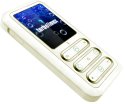 TurboLinux Wizpy — Oct. 01, 2007 — This unique PMP (portable media player) from TurboLinux doubles as a personal USB-based Linux boot device. The Wizpy supports DivX, MP3, Ogg, AAC, and JPEG media formats, offers a 1.7-inch OLED (organic light-emitting diode) display, and in the latest version, adds support for Omnidrive-based network-based file storage.
TurboLinux Wizpy — Oct. 01, 2007 — This unique PMP (portable media player) from TurboLinux doubles as a personal USB-based Linux boot device. The Wizpy supports DivX, MP3, Ogg, AAC, and JPEG media formats, offers a 1.7-inch OLED (organic light-emitting diode) display, and in the latest version, adds support for Omnidrive-based network-based file storage.
![]() Levelstar Icon — Jul. 25, 2007 — Designed for visually impaired users, Levelstar's Icon PDA offers a full complement of "life managing software," much of it written for blind users. The device is equipped with a 30GB hard drive, WiFi, Bluetooth, USB, and either a telephone-style keypad or a braille reader interface.
Levelstar Icon — Jul. 25, 2007 — Designed for visually impaired users, Levelstar's Icon PDA offers a full complement of "life managing software," much of it written for blind users. The device is equipped with a 30GB hard drive, WiFi, Bluetooth, USB, and either a telephone-style keypad or a braille reader interface.
 LearningSoft Indigo Learning System — — LearningSoft's handheld "assessment system" is aimed at helping K8 classroom school teachers create, administer, and score tests. The Indigo Learning System hardware is based on the Zipit IM chat device, but runs a custom software stack.
LearningSoft Indigo Learning System — — LearningSoft's handheld "assessment system" is aimed at helping K8 classroom school teachers create, administer, and score tests. The Indigo Learning System hardware is based on the Zipit IM chat device, but runs a custom software stack.
 iWave Systems iW-Rugged-PDA — May 09, 2007 — This ruggedized, military-grade PDA from India-based iWave Systems supports SDIO WiFi and GPS receiver modules. The "iW-Rugged-PDA" is based on a 520MHz Marvell PXA270, and can operate in "extreme outdoor and industrial environments."
iWave Systems iW-Rugged-PDA — May 09, 2007 — This ruggedized, military-grade PDA from India-based iWave Systems supports SDIO WiFi and GPS receiver modules. The "iW-Rugged-PDA" is based on a 520MHz Marvell PXA270, and can operate in "extreme outdoor and industrial environments."
 SanDisk Sansa Connect — Apr. 09, 2007 — SanDisk's portable multimedia player (PMP) can download music from online music services directly via WiFi, without the use of a PC. The Sansa Connect runs embedded Linux and Mono, and offers a 2.2-inch color LCD screen and a built-in 4GB hard drive.
SanDisk Sansa Connect — Apr. 09, 2007 — SanDisk's portable multimedia player (PMP) can download music from online music services directly via WiFi, without the use of a PC. The Sansa Connect runs embedded Linux and Mono, and offers a 2.2-inch color LCD screen and a built-in 4GB hard drive.
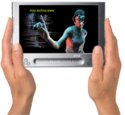 Archos 704 — Mar. 09, 2007 — This upgraded PMP (portable media player) from Archos is larger than the earlier Archos 604 and most other PMPs, but compensates with a bright, detailed, 7-inch screen. The Archos 704 features an 80GB hard drive, a 802.11b/g WiFi radio, and an Opera browser.
Archos 704 — Mar. 09, 2007 — This upgraded PMP (portable media player) from Archos is larger than the earlier Archos 604 and most other PMPs, but compensates with a bright, detailed, 7-inch screen. The Archos 704 features an 80GB hard drive, a 802.11b/g WiFi radio, and an Opera browser.
 Samsung LMD10A-51W Digital Multimedia Broadcast TV (DMB-TV) — Jan. 12, 2007 — Samsung Electronics used Linux and a DivX-accelerated MIPS-based SoC (system-on-chip) to build a portable digital TV. The LMD10A-51W mobile Digital Multimedia Broadcast TV (DMB-TV) has a 10-inch WVGA (800×480) screen, and supports T-DMB broadcasts as well as DivX, XviD, WMV, and MPEG files.
Samsung LMD10A-51W Digital Multimedia Broadcast TV (DMB-TV) — Jan. 12, 2007 — Samsung Electronics used Linux and a DivX-accelerated MIPS-based SoC (system-on-chip) to build a portable digital TV. The LMD10A-51W mobile Digital Multimedia Broadcast TV (DMB-TV) has a 10-inch WVGA (800×480) screen, and supports T-DMB broadcasts as well as DivX, XviD, WMV, and MPEG files.
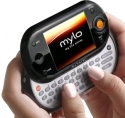 Sony MYLO ("My Life Online") — Nov. 1, 2006 — A Linux-based, WiFi-equipped multifunction handheld based on an ARM9-based i.MX21 SoC (system-on-chip). It features a built-in Qwerty thumb keyboard and Skype voice messaging client.
Sony MYLO ("My Life Online") — Nov. 1, 2006 — A Linux-based, WiFi-equipped multifunction handheld based on an ARM9-based i.MX21 SoC (system-on-chip). It features a built-in Qwerty thumb keyboard and Skype voice messaging client.
 Archos Archos 604 — Sep. 07, 2006 — The Archos 604 portable media player (PMP) offers a 4.3-inch 480×272 display, 30GB hard drive, TV out, and USB 2.0 connectivity. Archos also sells a WiFi-enabled version of the PMP.
Archos Archos 604 — Sep. 07, 2006 — The Archos 604 portable media player (PMP) offers a 4.3-inch 480×272 display, 30GB hard drive, TV out, and USB 2.0 connectivity. Archos also sells a WiFi-enabled version of the PMP.
 AML M5900 and M5900i — Sep. 1, 2006 — A handheld data terminal based on embedded Linux, the basic M5900 and ruggedized M5900i for industrial applications target batch data collection applications, including inventory control, factory floor management, price verification, shipping/receiving, and asset tracking.
AML M5900 and M5900i — Sep. 1, 2006 — A handheld data terminal based on embedded Linux, the basic M5900 and ruggedized M5900i for industrial applications target batch data collection applications, including inventory control, factory floor management, price verification, shipping/receiving, and asset tracking.
 Tripod Data Systems Recon-X — Sep. 1, 2006 — This Linux-ized version of a ruggedized, "military-grade" PDA was ported to Linux by SDG. It is based on a 2.6.15 kernel, and comes with technical and warranty support. Tools, training, and customization services are also available. Details
Tripod Data Systems Recon-X — Sep. 1, 2006 — This Linux-ized version of a ruggedized, "military-grade" PDA was ported to Linux by SDG. It is based on a 2.6.15 kernel, and comes with technical and warranty support. Tools, training, and customization services are also available. Details
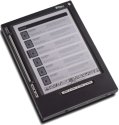 iRex Iliad eBook Reader — Aug. 1, 2006 — An electronic paper display (EPD) helps save power in this portable, Linux-based reading device, available now for personal and business-to-business applications. The iLiad's paper display "reads just like paper, and is perceived as such by the human eye," according to the company.
iRex Iliad eBook Reader — Aug. 1, 2006 — An electronic paper display (EPD) helps save power in this portable, Linux-based reading device, available now for personal and business-to-business applications. The iLiad's paper display "reads just like paper, and is perceived as such by the human eye," according to the company.
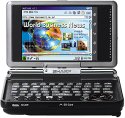 Sharp SL-C3200 — Aug. 1, 2006 — Sharp's Linux-based Zaurus PDA was ahead of its time, and can still compete with modern Linux-based handhelds such as the Nokia 770 Internet Tablet, writes MobileTechReview Editor-in-Chief Lisa Gade in a mostly-positive review of the SL-C3200 model. Details
Sharp SL-C3200 — Aug. 1, 2006 — Sharp's Linux-based Zaurus PDA was ahead of its time, and can still compete with modern Linux-based handhelds such as the Nokia 770 Internet Tablet, writes MobileTechReview Editor-in-Chief Lisa Gade in a mostly-positive review of the SL-C3200 model. Details
 Acer n30 — Apr. 1, 2006 — A thin, inexpensive PDA capable of dual-booting the Letux project's software stack.
Acer n30 — Apr. 1, 2006 — A thin, inexpensive PDA capable of dual-booting the Letux project's software stack.
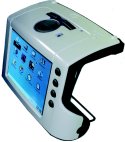 Eurotech WWPC (wrist-worn PC) — Mar. 1, 2006 — A wrist-worn wearable computer that runs embedded Linux or Windows CE, Eurotech's WWPC ("wrist-worn PC") offers standard PC interfaces, along with several innovative wearable-specific features. It targets emergency rescue, security, healthcare, maintenance, logistics, and "many other" applications.
Eurotech WWPC (wrist-worn PC) — Mar. 1, 2006 — A wrist-worn wearable computer that runs embedded Linux or Windows CE, Eurotech's WWPC ("wrist-worn PC") offers standard PC interfaces, along with several innovative wearable-specific features. It targets emergency rescue, security, healthcare, maintenance, logistics, and "many other" applications.
 Tripod Data Systems Recon — Nov. 30, 2005 — A rugged PDA targeting military, transportation, industrial, and public service applications, the Recon was ported to Linux by SDG Systems, which resells the device pre-installed with Linux.
Tripod Data Systems Recon — Nov. 30, 2005 — A rugged PDA targeting military, transportation, industrial, and public service applications, the Recon was ported to Linux by SDG Systems, which resells the device pre-installed with Linux.
 Sharp Zaurus SL-C3100 — Sep. 16, 2005 — Sharp Japan has given US-based Linux PDA fans one more reason to wish the dollar could hold its own against the Yen. The newly shipping (in Japan only) SL-C3100 is the second harddrive-equipped Zaurus model, and it also features English-language software aimed at Japanese students.
Sharp Zaurus SL-C3100 — Sep. 16, 2005 — Sharp Japan has given US-based Linux PDA fans one more reason to wish the dollar could hold its own against the Yen. The newly shipping (in Japan only) SL-C3100 is the second harddrive-equipped Zaurus model, and it also features English-language software aimed at Japanese students.
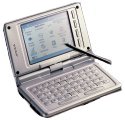 Unication Magpie — Jun. 14, 2005 — A Linux-based PDA from Taiwanese pager maker Unication, the Magpie offers unique and sophisticated features, including an integrated FM transmitter, WiFi, and full Opera browser.
Unication Magpie — Jun. 14, 2005 — A Linux-based PDA from Taiwanese pager maker Unication, the Magpie offers unique and sophisticated features, including an integrated FM transmitter, WiFi, and full Opera browser.
 Nokia 770 Internet Tablet — May. 25, 2005 — A PDA-sized Internet tablet designed for email and web-browsing, the 770 boasts a large, WVGA (800×480) screen, plus built-in WiFi and Bluetooth wireless. In addition to a full Opera browser, its software suite includes an email client, Internet radio, news reader, media players, image viewers, and more.
Nokia 770 Internet Tablet — May. 25, 2005 — A PDA-sized Internet tablet designed for email and web-browsing, the 770 boasts a large, WVGA (800×480) screen, plus built-in WiFi and Bluetooth wireless. In addition to a full Opera browser, its software suite includes an email client, Internet radio, news reader, media players, image viewers, and more.
 Simputer — Apr. 14, 2005 — The "Simputer" was first described in a concept paper presented at the first Bangalore IT.com conference in 1998. Later, a "Simputer Trust" was formed dedicated to realizing the concept as a "platform for social change," a computer with price and technology appropriate for rural Indian villages. After three years of development by two competing companies, Pico Peta has released the Amida, the first Simputer. More details here
Simputer — Apr. 14, 2005 — The "Simputer" was first described in a concept paper presented at the first Bangalore IT.com conference in 1998. Later, a "Simputer Trust" was formed dedicated to realizing the concept as a "platform for social change," a computer with price and technology appropriate for rural Indian villages. After three years of development by two competing companies, Pico Peta has released the Amida, the first Simputer. More details here
 TDS Recon — Apr. 2, 2005 — An extremely rugged military-grade PDA ported to Linux by SDG Systems, a vertical market software company serving the rail industry, the TDS "Recon" PDA, which meets MIL-STD-810F standards for drops, vibration, and temperature extremes.
TDS Recon — Apr. 2, 2005 — An extremely rugged military-grade PDA ported to Linux by SDG Systems, a vertical market software company serving the rail industry, the TDS "Recon" PDA, which meets MIL-STD-810F standards for drops, vibration, and temperature extremes.
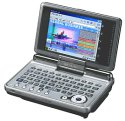 Sharp Zaurus SL-C1000 — Mar. 14, 2005 — The SL-C1000 is similar to the SL-C3000, but without an internal harddrive.
Sharp Zaurus SL-C1000 — Mar. 14, 2005 — The SL-C1000 is similar to the SL-C3000, but without an internal harddrive.
 Archos PMA400 Pocket Multimedia Assistant — Feb. 18, 2005 — this device combines PDA features with those of a personal video recorder/player (PVR/PVP). It boasts a 3.5-inch color LCD, 30GB hard drive, wireless Internet access, Trolltech Qtopia PDA application framework and PIM suite, and lots of other cool features, including a Linux SDK. More details here
Archos PMA400 Pocket Multimedia Assistant — Feb. 18, 2005 — this device combines PDA features with those of a personal video recorder/player (PVR/PVP). It boasts a 3.5-inch color LCD, 30GB hard drive, wireless Internet access, Trolltech Qtopia PDA application framework and PIM suite, and lots of other cool features, including a Linux SDK. More details here
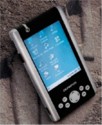 Olympus Tough Digital Assistant — Feb. 1, 2005 — the slim, light-weight TDAs run Linux 2.4.18 (with Qtopia v1.7.0) on a Freescale MXL processor, come with up to 128MB RAM and 256MB Flash, and offer built-in Bluetooth and optional 802.11b wireless.
Olympus Tough Digital Assistant — Feb. 1, 2005 — the slim, light-weight TDAs run Linux 2.4.18 (with Qtopia v1.7.0) on a Freescale MXL processor, come with up to 128MB RAM and 256MB Flash, and offer built-in Bluetooth and optional 802.11b wireless.
 Sharp Zaurus SL-6000 — Nov. 2, 2004 — Sharp officially stopped distributing the SL-6000 in the U.S. However, the device is still available here, from a company that makes verticle market software for the rail industry. The SL-6000 has a 640×480 high-brightness VGA display, along with "laptop-like" performance and a ruggedized case.
Sharp Zaurus SL-6000 — Nov. 2, 2004 — Sharp officially stopped distributing the SL-6000 in the U.S. However, the device is still available here, from a company that makes verticle market software for the rail industry. The SL-6000 has a 640×480 high-brightness VGA display, along with "laptop-like" performance and a ruggedized case.
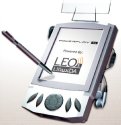 Empower PowerPlay 1x — Oct. 27, 2004 — Empower plans to ship a $200 Linux-based PDA with a color display by December, 2004. The PowerPlay 1x is based on a dual-core RISC/DSP Texas Instruments OMAP5910 processor, along with the company's LEOs (LinuxDA Embedded Operating System) software platform.
Empower PowerPlay 1x — Oct. 27, 2004 — Empower plans to ship a $200 Linux-based PDA with a color display by December, 2004. The PowerPlay 1x is based on a dual-core RISC/DSP Texas Instruments OMAP5910 processor, along with the company's LEOs (LinuxDA Embedded Operating System) software platform.
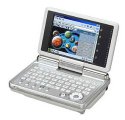 Sharp SL-C3000 — Oct. 26, 2004 — The SL-C3000, includes a tiny 4GB hard disk drive made by Hitachi. The Linux-based PDA is officially available only in Japan, but various international distributors will also offer the device to buys in the US and elsewhere. details
Sharp SL-C3000 — Oct. 26, 2004 — The SL-C3000, includes a tiny 4GB hard disk drive made by Hitachi. The Linux-based PDA is officially available only in Japan, but various international distributors will also offer the device to buys in the US and elsewhere. details
 Node Explorer v2 — Sep. 28, 2004 — A rugged handheld computer and GPS unit intended for location-aware interactive exploration of indoor and outdoor spaces. The Explorer v2 is based on a 400MHz XScale processor.
Node Explorer v2 — Sep. 28, 2004 — A rugged handheld computer and GPS unit intended for location-aware interactive exploration of indoor and outdoor spaces. The Explorer v2 is based on a 400MHz XScale processor.
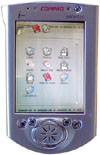 Compaq iPAQ — Jun. 23, 2004 — Though not natively equipped with Embedded Linux, there are now multiple projects to develop Linux implementations for the iPAQ, including one from the Compaq-sponsored handhelds.org site. The iPAQ has a 240 x 320 pixel backlit color LCD screen and is powered by a 206MHz Intel StrongArm processor with 32MB of RAM and 16MB of flash memory. External interfacing and expansion are via IrDA, serial (sync/async), USB, and PCMCIA. Multiple sources of Embedded Linux support for the iPAQ are available, and discussed in the references section of this guide (below). In particular, the Familiar Project stands out.
Compaq iPAQ — Jun. 23, 2004 — Though not natively equipped with Embedded Linux, there are now multiple projects to develop Linux implementations for the iPAQ, including one from the Compaq-sponsored handhelds.org site. The iPAQ has a 240 x 320 pixel backlit color LCD screen and is powered by a 206MHz Intel StrongArm processor with 32MB of RAM and 16MB of flash memory. External interfacing and expansion are via IrDA, serial (sync/async), USB, and PCMCIA. Multiple sources of Embedded Linux support for the iPAQ are available, and discussed in the references section of this guide (below). In particular, the Familiar Project stands out.
 NexGen City NexPaq — May. 6, 2004 — NexGen City has embedded Linux into the first VoIP (voice over internet protocol) push-to-talk (PTT) handset for emergency workers and "first responders." The "NexPaq" is currently undergoing testing in the first NexLink mesh network, which is nearing completion in Garland, Texas. The Garland network covers 57 square miles, and is the first deployment of mobile mesh networking technology for use by a public safety organization, according to NexGen. The NexPaq also includes basic PDA features.
NexGen City NexPaq — May. 6, 2004 — NexGen City has embedded Linux into the first VoIP (voice over internet protocol) push-to-talk (PTT) handset for emergency workers and "first responders." The "NexPaq" is currently undergoing testing in the first NexLink mesh network, which is nearing completion in Garland, Texas. The Garland network covers 57 square miles, and is the first deployment of mobile mesh networking technology for use by a public safety organization, according to NexGen. The NexPaq also includes basic PDA features.
 Intermec CK-1 batch data terminal — Mar. 16, 2004 — A low-cost batch data collection terminal based on embedded Linux, the ruggedized "CK1" key-entry handheld runs a 2.4 uClinux kernel, supports off-the-shelf use as barcode scanner and linear imager, and is extensible through several application development environments. The CK1 targets parcel pickup and delivery, retail inventory management, medical/pharmaceutical applications, or light industrial use.
Intermec CK-1 batch data terminal — Mar. 16, 2004 — A low-cost batch data collection terminal based on embedded Linux, the ruggedized "CK1" key-entry handheld runs a 2.4 uClinux kernel, supports off-the-shelf use as barcode scanner and linear imager, and is extensible through several application development environments. The CK1 targets parcel pickup and delivery, retail inventory management, medical/pharmaceutical applications, or light industrial use.
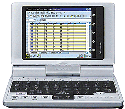 Sharp Zaurus SL-C7xx, C8xx Series — Nov. 12, 2003 — Sharp calls the SL-C7xx PDAs "the world's first PDAs with a full-color VGA-resolution (640×480 pixel) LCD display." The SL-C7xx PDAs also provide a unique built-in QWERTY keyboard similar to that of a normal notebook keyboard (although smaller). As with previous Zaurus models, the software platform is based on embedded Linux along with a Java virtual machine for enhanced software portability and world-wide open source developer support. SL-C700 / SL-C750, SLC760, C860
Sharp Zaurus SL-C7xx, C8xx Series — Nov. 12, 2003 — Sharp calls the SL-C7xx PDAs "the world's first PDAs with a full-color VGA-resolution (640×480 pixel) LCD display." The SL-C7xx PDAs also provide a unique built-in QWERTY keyboard similar to that of a normal notebook keyboard (although smaller). As with previous Zaurus models, the software platform is based on embedded Linux along with a Java virtual machine for enhanced software portability and world-wide open source developer support. SL-C700 / SL-C750, SLC760, C860
 CDL Paron 'secure PDA' — Nov. 6, 2003 — This unique device is claimed to be the world's first handheld wireless device with built-in biometric user authentication. It combines the functions of a PDA, Bluetooth wireless access, cellular telephone, and biometric fingerprint recognition, along with a security-oriented hardware/software architecture. The device has a 320×240 pixel color LCD and is based on a 206MHz StrongARM SA-1110 processor with 32MB or 64MB RAM and 32MB Flash, and uses a Linux 2.4.x kernel and provides a PDA app suite and web browser.
CDL Paron 'secure PDA' — Nov. 6, 2003 — This unique device is claimed to be the world's first handheld wireless device with built-in biometric user authentication. It combines the functions of a PDA, Bluetooth wireless access, cellular telephone, and biometric fingerprint recognition, along with a security-oriented hardware/software architecture. The device has a 320×240 pixel color LCD and is based on a 206MHz StrongARM SA-1110 processor with 32MB or 64MB RAM and 32MB Flash, and uses a Linux 2.4.x kernel and provides a PDA app suite and web browser.
 G.Mate Yopy — Oct. 18, 2003 — The Yopy integrates the functions of Internet and email access (via mobile phone), digital voice recorder, MP3 (audio) and MPEG (video) player, video games, plus a full set of PDA applications. The YP3000 has a full-color QVGA (240 x 320 pixel) display, is based on a 206MHz Intel StrongARM processor equipped with 64MB RAM and 16MB FLash, and provides both RS232 serial and USB expansion interfaces. The YP3500 adds a display backlight plus increased memory (128MB RAM, 32MB Flash) to the YP3000, while the YP3700 adds increased memory and a built-in CompactFlash and MMC sockets. YP3000 / YP3000 review / YP3500 / YP3700
G.Mate Yopy — Oct. 18, 2003 — The Yopy integrates the functions of Internet and email access (via mobile phone), digital voice recorder, MP3 (audio) and MPEG (video) player, video games, plus a full set of PDA applications. The YP3000 has a full-color QVGA (240 x 320 pixel) display, is based on a 206MHz Intel StrongARM processor equipped with 64MB RAM and 16MB FLash, and provides both RS232 serial and USB expansion interfaces. The YP3500 adds a display backlight plus increased memory (128MB RAM, 32MB Flash) to the YP3000, while the YP3700 adds increased memory and a built-in CompactFlash and MMC sockets. YP3000 / YP3000 review / YP3500 / YP3700
 Royal LineaLX — Sep. 16, 2003 — This PDA features software compatibility with Sharp's Zaurus PDAs. The first is scheduled to ship in the U.S. in the fourth quarter of 2003 for less than $300. LineaLX will be based on a Motorola i.MX1 MDragonBall processor running at 200MHz. It will come with 64MB SDRAM plus 32MB Flash memory and an SDIO expansion card slot, and the device will feature a 3.5-inch LCD screen with 240 x 320 pixel resolution and 65K colors.
Royal LineaLX — Sep. 16, 2003 — This PDA features software compatibility with Sharp's Zaurus PDAs. The first is scheduled to ship in the U.S. in the fourth quarter of 2003 for less than $300. LineaLX will be based on a Motorola i.MX1 MDragonBall processor running at 200MHz. It will come with 64MB SDRAM plus 32MB Flash memory and an SDIO expansion card slot, and the device will feature a 3.5-inch LCD screen with 240 x 320 pixel resolution and 65K colors.
 WebLink Wireless Sun Telecom S-935 — Mar. 19, 2003 — this Linux-based two-way pager is a "clamshell"-like device that provides full PDA capabilities, syncing, secure wireless communications between work groups, and encrypted access to company email/data. A J2ME VM is included for the PIM suite, syncing, and custom application support.
WebLink Wireless Sun Telecom S-935 — Mar. 19, 2003 — this Linux-based two-way pager is a "clamshell"-like device that provides full PDA capabilities, syncing, secure wireless communications between work groups, and encrypted access to company email/data. A J2ME VM is included for the PIM suite, syncing, and custom application support.
 IBM e-LAP reference design — Jan. 21, 2003 — Dubbed the "embedded Linux application platform" (e-LAP), this ready-to-use (and easily modified) PDA reference design based on IBM's PowerPC 405LP processor includes 32MB SDRAM, 32MB NOR Flash (NOR), 64MB DiskOnChip Flash, a 4-inch 240×320 pixel color LCD, a TCPA security chip, USB host/device, SDIO, and sound, plus a full Linux embedded software stack including a browser and a J2ME VM.
IBM e-LAP reference design — Jan. 21, 2003 — Dubbed the "embedded Linux application platform" (e-LAP), this ready-to-use (and easily modified) PDA reference design based on IBM's PowerPC 405LP processor includes 32MB SDRAM, 32MB NOR Flash (NOR), 64MB DiskOnChip Flash, a 4-inch 240×320 pixel color LCD, a TCPA security chip, USB host/device, SDIO, and sound, plus a full Linux embedded software stack including a browser and a J2ME VM.
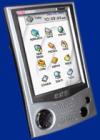 GSPDA V-2002 — Nov. 22, 2002 — This Linux PDA for the Chinese market is based on a 206 MHz Intel StrongARM processor with 32MB RAM and 32MB NOR Flash memory, plus USB, audio in/out, built-in BlueTooth, and an SD Card slot.
GSPDA V-2002 — Nov. 22, 2002 — This Linux PDA for the Chinese market is based on a 206 MHz Intel StrongARM processor with 32MB RAM and 32MB NOR Flash memory, plus USB, audio in/out, built-in BlueTooth, and an SD Card slot.
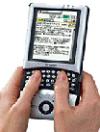 Sharp Zaurus SL-5×00 — Nov. 12, 2002 — Sharp's first Linux PDA for the worldwide market features an embedded Linux OS supplemented by Qt and a Java runtime environment. The SL-5500 is based on a 206 MHz Intel StrongARM processor with 64MB system RAM and 16MB built-in flash storage, while the SL-5600 uses a 400 MHz Intel XScale processor and has 32MB system RAM and 64MB built-in flash storage. Both models have a full-color 320 x 240 pixel TFT LCD with touch panel, plus a miniature built-in QWERTY keyboard (accessed via a sliding cover), and are equipped with CompactFlash and SD-card slots, IrDA, and USB interfaces. details: SL-5600 / SL-5500 / review of SL-5000D (developer edition)
Sharp Zaurus SL-5×00 — Nov. 12, 2002 — Sharp's first Linux PDA for the worldwide market features an embedded Linux OS supplemented by Qt and a Java runtime environment. The SL-5500 is based on a 206 MHz Intel StrongARM processor with 64MB system RAM and 16MB built-in flash storage, while the SL-5600 uses a 400 MHz Intel XScale processor and has 32MB system RAM and 64MB built-in flash storage. Both models have a full-color 320 x 240 pixel TFT LCD with touch panel, plus a miniature built-in QWERTY keyboard (accessed via a sliding cover), and are equipped with CompactFlash and SD-card slots, IrDA, and USB interfaces. details: SL-5600 / SL-5500 / review of SL-5000D (developer edition)
 Sharp Zaurus SL-A300 Personal Mobile Tool — Oct. 18, 2002 — This model Zaurus Linux PDA, currently exclusive to the Japanese market, is claimed to be the world's smallest and lightest PDA among QVGA color LCD-equipped handhelds (as of June 2002). The device is based on a 200 MHz Intel PXA210 XScale processor equipped with 64 MB SDRAM memory, and offers USB, IrDA, and audio I/O, plus an SD card expansion slot.
Sharp Zaurus SL-A300 Personal Mobile Tool — Oct. 18, 2002 — This model Zaurus Linux PDA, currently exclusive to the Japanese market, is claimed to be the world's smallest and lightest PDA among QVGA color LCD-equipped handhelds (as of June 2002). The device is based on a 200 MHz Intel PXA210 XScale processor equipped with 64 MB SDRAM memory, and offers USB, IrDA, and audio I/O, plus an SD card expansion slot.
 AML M7100 wireless data collection terminal — Oct. 18, 2002 — This handheld device for the retail market is powered by a StrongARM SA-1110 processor, equipped with 16MB RAM and 4MB Flash ROM. Its input/output interfaces include multiple scanner inputs, RS232, USB, infrared (IrDA), and a built-in IEEE 802.11b radio. Details
AML M7100 wireless data collection terminal — Oct. 18, 2002 — This handheld device for the retail market is powered by a StrongARM SA-1110 processor, equipped with 16MB RAM and 4MB Flash ROM. Its input/output interfaces include multiple scanner inputs, RS232, USB, infrared (IrDA), and a built-in IEEE 802.11b radio. Details
 Infomart Kaii — Oct. 2, 2002 — This new Linux-based PDA was created to fill a gap between high-end, high-cost Pocket PC PDAs and low-end, low-cost Palm PDAs. The device attempts to offer a high level of software compatibility with the Zaurus, by employing a similar software platform. Unlike the Zaurus, however, the Kaii uses a 160MHz Hitachi SH3 processor and provides an on-screen, rather than physical, keyboard. Includes 32-128MB RAM along with 32MB of ROM (or Flash), depending on version.
Infomart Kaii — Oct. 2, 2002 — This new Linux-based PDA was created to fill a gap between high-end, high-cost Pocket PC PDAs and low-end, low-cost Palm PDAs. The device attempts to offer a high level of software compatibility with the Zaurus, by employing a similar software platform. Unlike the Zaurus, however, the Kaii uses a 160MHz Hitachi SH3 processor and provides an on-screen, rather than physical, keyboard. Includes 32-128MB RAM along with 32MB of ROM (or Flash), depending on version.
 Q-Reader Ebook — Jul. 24, 2002 — This Linux-powered electronic reading device targets the education market in China. As well as reading capabilities, the multi-function device includes Web connectivity, email, and other PDA features, including support for both English and Chinese languages.
Q-Reader Ebook — Jul. 24, 2002 — This Linux-powered electronic reading device targets the education market in China. As well as reading capabilities, the multi-function device includes Web connectivity, email, and other PDA features, including support for both English and Chinese languages.
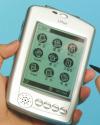 Esfia PDA reference design — Jul. 21, 2002 — Based on a Samsung ARM7 system-on-chip processor and a uClinux embedded OS, this reference design supports a color or monochrome backlit 320×240 pixel LCD and is available for license to companies wanting to distribute low-cost Linux-based PDAs in either the China or worldwide markets. Resources include up to 32MB SDRAM, 8MB NAND Flash, IrDA, RS232, USB, stereo-audio, and CompactFlash and SD card slots.
Esfia PDA reference design — Jul. 21, 2002 — Based on a Samsung ARM7 system-on-chip processor and a uClinux embedded OS, this reference design supports a color or monochrome backlit 320×240 pixel LCD and is available for license to companies wanting to distribute low-cost Linux-based PDAs in either the China or worldwide markets. Resources include up to 32MB SDRAM, 8MB NAND Flash, IrDA, RS232, USB, stereo-audio, and CompactFlash and SD card slots.
 Mizi Linux PDA developer kit — Jul. 19, 2002 — The PDA bundled with this kit, called the EnDA C3224, is based on a 206 MHz StrongARM SA-1110 processor and has a 240 x 320 pixel TFT LCD. Other resources include 32M RAM and 32MB Flash memory, a CompactFlash slot, USB and IrDA interfaces, internal digital FM stereo radio, and a built-in speaker.
Mizi Linux PDA developer kit — Jul. 19, 2002 — The PDA bundled with this kit, called the EnDA C3224, is based on a 206 MHz StrongARM SA-1110 processor and has a 240 x 320 pixel TFT LCD. Other resources include 32M RAM and 32MB Flash memory, a CompactFlash slot, USB and IrDA interfaces, internal digital FM stereo radio, and a built-in speaker.
 Softfield VR3 — Apr. 25, 2002 — The Softfield Technologies VR3 (originally introduced by Agenda Computing) is a full-function handheld computer with a 160 x 240 pixel (2 x 3 in. viewable area) backlit LCD. It is based on a 66MHz 32-bit NEC VR4181 MIPS processor, and has 8MB or 16MB of system RAM and 16MB of built-in Flash storage. For I/O, the device provides an RS232 serial port along with an IrDA interface. The VR3's operating system is Linux-VR.
Softfield VR3 — Apr. 25, 2002 — The Softfield Technologies VR3 (originally introduced by Agenda Computing) is a full-function handheld computer with a 160 x 240 pixel (2 x 3 in. viewable area) backlit LCD. It is based on a 66MHz 32-bit NEC VR4181 MIPS processor, and has 8MB or 16MB of system RAM and 16MB of built-in Flash storage. For I/O, the device provides an RS232 serial port along with an IrDA interface. The VR3's operating system is Linux-VR.
 Empower PowerPlay — Mar. 11, 2002 — The PowerPlay III and PowerPlay V PDAs are manufactured in Taiwan and sold online by Empower Technologies, a vendor of Embedded Linux for intelligent appliances. The devices are claimed to be Palm IIIxe and Vx compatible, respectively, from a hardware perspective. But unlike Palm's PDAs, the PowerPlay PDAs run Empower Technologies' Linux DA O/S implementation of Embedded Linux for the Dragonball processor.
Empower PowerPlay — Mar. 11, 2002 — The PowerPlay III and PowerPlay V PDAs are manufactured in Taiwan and sold online by Empower Technologies, a vendor of Embedded Linux for intelligent appliances. The devices are claimed to be Palm IIIxe and Vx compatible, respectively, from a hardware perspective. But unlike Palm's PDAs, the PowerPlay PDAs run Empower Technologies' Linux DA O/S implementation of Embedded Linux for the Dragonball processor.
 Royal [email protected] — Jan. 10, 2002 — Royal Consumer Information Products unveiled a prototype of a new Linux-powered PDA at CES in Las Vegas, NV in January, 2002. The device was based on a 206 MHz Intel StrongARM processor with 32MB system RAM and 16MB built-in flash storage. It had a full-color 320 x 240 pixel TFT LCD with touch panel, and was equipped with a CompactFlash expansion slot, USB, IrDA, and an RS232 serial port. The device's software stack was based on Century Software's PIXIL PDA software suite, which includes the Microwindows GUI. However, this device never reached production.
Royal [email protected] — Jan. 10, 2002 — Royal Consumer Information Products unveiled a prototype of a new Linux-powered PDA at CES in Las Vegas, NV in January, 2002. The device was based on a 206 MHz Intel StrongARM processor with 32MB system RAM and 16MB built-in flash storage. It had a full-color 320 x 240 pixel TFT LCD with touch panel, and was equipped with a CompactFlash expansion slot, USB, IrDA, and an RS232 serial port. The device's software stack was based on Century Software's PIXIL PDA software suite, which includes the Microwindows GUI. However, this device never reached production.
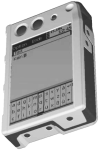 Invair Filewalker — Jan. 10, 2002 — Invair Technologies (Stuttgart, Germany) unveiled a new Linux-based PDA at CeBIT 2002 in Hannover, Germany. The device was designed to be operated with one hand, weighs a mere 0.2 lbs, and is small (though somewhat thick), at 3.4 x 2.2 x .74 in. It's based on an Intel StrongARM processor clocked at 133MHz and includes 32MB SDRAM and 16MB Flash ROM, has a 160 x 240 pixel grayscale LCD display, and provides IrDA and USB interfaces plus an expansion slot for SD and MMC cards.
Invair Filewalker — Jan. 10, 2002 — Invair Technologies (Stuttgart, Germany) unveiled a new Linux-based PDA at CeBIT 2002 in Hannover, Germany. The device was designed to be operated with one hand, weighs a mere 0.2 lbs, and is small (though somewhat thick), at 3.4 x 2.2 x .74 in. It's based on an Intel StrongARM processor clocked at 133MHz and includes 32MB SDRAM and 16MB Flash ROM, has a 160 x 240 pixel grayscale LCD display, and provides IrDA and USB interfaces plus an expansion slot for SD and MMC cards.
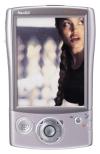 HanGil C3224 multimedia PDA — Nov. 11, 2001 — Based on a 206 MHz 32-bit Intel StrongARM SA-1110 system-on-chip processor plus 16MB RAM and 16MB Flash. The display is a 3.8-inch full color Quarter VGA (240 x 320 pixel) TFT LCD, with touchpad, and the device offers built-in USB, IrDA, and RS232C interfaces along with CompactFlash expandability.
HanGil C3224 multimedia PDA — Nov. 11, 2001 — Based on a 206 MHz 32-bit Intel StrongARM SA-1110 system-on-chip processor plus 16MB RAM and 16MB Flash. The display is a 3.8-inch full color Quarter VGA (240 x 320 pixel) TFT LCD, with touchpad, and the device offers built-in USB, IrDA, and RS232C interfaces along with CompactFlash expandability.
 MasterIA PDA — Nov. 7, 2001 — Like many recently introduced PDAs, this device is based on Intel's 206MHz StrongARM SA-1110 system-on-chip processor, and has a full-color 320×240 pixel TFT LCD screen plus expansion slots for CompactFlash Type II and SmartData (SD) cards. Internal resources include 32MB RAM for program operation, and either 16MB or 32MB of Flash memory for program and data storage.
MasterIA PDA — Nov. 7, 2001 — Like many recently introduced PDAs, this device is based on Intel's 206MHz StrongARM SA-1110 system-on-chip processor, and has a full-color 320×240 pixel TFT LCD screen plus expansion slots for CompactFlash Type II and SmartData (SD) cards. Internal resources include 32MB RAM for program operation, and either 16MB or 32MB of Flash memory for program and data storage.
 CIIT multimedia PDA — Aug. 31, 2001 — Based on an Intel 206 MHz StrongARM SA-1110 system-on-chip processor with 32MB of DRAM and 32MB of Flash storage memory. I/O connections include USB, serial, and Ethernet ports, and there is a CompactFlash slot for additional expansion (memory or I/O). The display is a 240 x 320 pixel, 4096-color LCD.
CIIT multimedia PDA — Aug. 31, 2001 — Based on an Intel 206 MHz StrongARM SA-1110 system-on-chip processor with 32MB of DRAM and 32MB of Flash storage memory. I/O connections include USB, serial, and Ethernet ports, and there is a CompactFlash slot for additional expansion (memory or I/O). The display is a 240 x 320 pixel, 4096-color LCD.
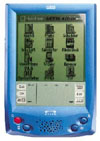 VTech Helio — Apr. 21, 2001 — Though not natively equipped with Embedded Linux, there are several implementations of Linux for the Helio in development. The device is based on a 75 MHz 32-bit RISC processor, with 8 MB of SDRAM and 2 MB Flash memory. It has a 160 x 160 pixel backlit LCD display with a 1024 x 1024 cell touchpad, integrated audio record/playback, and both standard and high-speed serial ports.
VTech Helio — Apr. 21, 2001 — Though not natively equipped with Embedded Linux, there are several implementations of Linux for the Helio in development. The device is based on a 75 MHz 32-bit RISC processor, with 8 MB of SDRAM and 2 MB Flash memory. It has a 160 x 160 pixel backlit LCD display with a 1024 x 1024 cell touchpad, integrated audio record/playback, and both standard and high-speed serial ports.
 HNT Exilien — Mar. 23, 2001 — The new Linux-based HNT handheld multimedia PCs will be made in two form-factorsa PDA-sized unit with a 3.8-inch 320×240 LCD, and a heftier sized device (one inch thick) with a backlit 4-inch TFT 640×480 LCD. The larger unit differs from the smaller one in several features, including LCD type, memory capacity, and type of expansion card slot. Both are based on a 206 MHz 32-bit Intel StrongARM SA-1110 system-on-chip processor along with a generous supply of DRAM and Flash memory.
HNT Exilien — Mar. 23, 2001 — The new Linux-based HNT handheld multimedia PCs will be made in two form-factorsa PDA-sized unit with a 3.8-inch 320×240 LCD, and a heftier sized device (one inch thick) with a backlit 4-inch TFT 640×480 LCD. The larger unit differs from the smaller one in several features, including LCD type, memory capacity, and type of expansion card slot. Both are based on a 206 MHz 32-bit Intel StrongARM SA-1110 system-on-chip processor along with a generous supply of DRAM and Flash memory.
 MiTAC CAT — Mar. 22, 2001 — The Linux-based CAT will initially be available only in Taiwan. The device is based on a 66 MHz NEC VR series processor with 8MB system memory and 4MB Flash, expandable via a CompactFlash slot. It has a 4.1-inch, 240 x 320 pixel, monochrome backlit STN LCD with and provides multiple connectivity options including IrDA, RS232, USB, and Bluetooth.
MiTAC CAT — Mar. 22, 2001 — The Linux-based CAT will initially be available only in Taiwan. The device is based on a 66 MHz NEC VR series processor with 8MB system memory and 4MB Flash, expandable via a CompactFlash slot. It has a 4.1-inch, 240 x 320 pixel, monochrome backlit STN LCD with and provides multiple connectivity options including IrDA, RS232, USB, and Bluetooth.
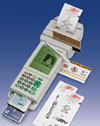 4P DAT500 rugged handheld — Dec. 8, 2000 — This is an industrial strength handheld computer, intended for use in mobile point-of-sale and inventory management applications. In addition to all the expected functions of a consumer palm-top computer (graphical user interface, touchscreen, handwriting recognition), the DAT500 is highly rugged and reliable, and has successfully passed testing for compliance with commercial aviation safety standards. The unit includes a built-in bar code scanner, credit card reader, smartcard interface, and printer.
4P DAT500 rugged handheld — Dec. 8, 2000 — This is an industrial strength handheld computer, intended for use in mobile point-of-sale and inventory management applications. In addition to all the expected functions of a consumer palm-top computer (graphical user interface, touchscreen, handwriting recognition), the DAT500 is highly rugged and reliable, and has successfully passed testing for compliance with commercial aviation safety standards. The unit includes a built-in bar code scanner, credit card reader, smartcard interface, and printer.
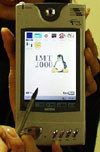 SK Telecom IMT2000 WebPhone — Sep. 19, 2000 — This device is a combination cell phone plus — PDA. It has a 4-in. LCD screen and a built in video camera, and looks like a PDA. The PDA functions of the device are based on a StrongARM SA1110 206MHz CPU, and the device contains 32MB of RAM plus up to 32MB of internal flash memory. The operating system software is PalmPalm's Tynux embedded Linux, with Qt/Embedded for GUI support plus Opera's browser. A separate microprocessor controls the cell phone functions.
SK Telecom IMT2000 WebPhone — Sep. 19, 2000 — This device is a combination cell phone plus — PDA. It has a 4-in. LCD screen and a built in video camera, and looks like a PDA. The PDA functions of the device are based on a StrongARM SA1110 206MHz CPU, and the device contains 32MB of RAM plus up to 32MB of internal flash memory. The operating system software is PalmPalm's Tynux embedded Linux, with Qt/Embedded for GUI support plus Opera's browser. A separate microprocessor controls the cell phone functions.
This article was originally published on LinuxDevices.com and has been donated to the open source community by QuinStreet Inc. Please visit LinuxToday.com for up-to-date news and articles about Linux and open source.